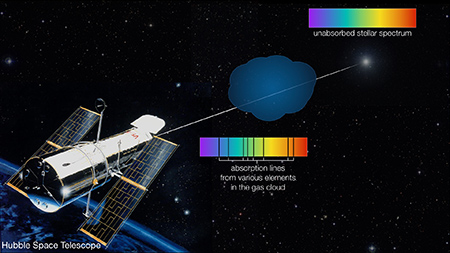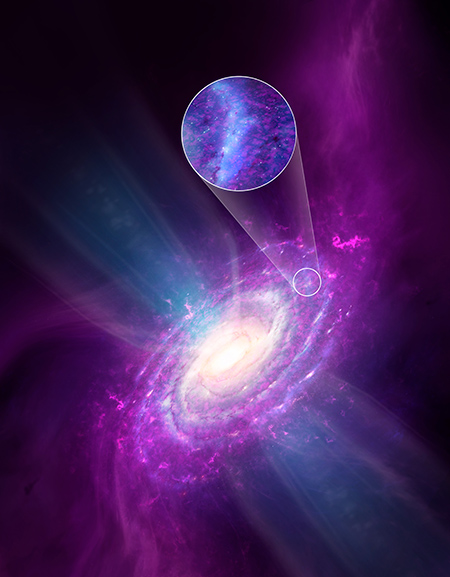THE COMPOSITION OF THE GAS IN THE MILKY WAY IS NOT HOMOGENEOUS
Astronomers from the University of Geneva (Switzerland), the Princeton University Observatory (USA) and the Institut d’astrophysique de Paris (IAP) have studied the composition of the gas in our Galaxy and show that, unlike the predictions from current models, this composition is very different from one place to another. Models of the evolution of the Milky Way will therefore have to be revised. These results are published in the Nature journal.
Galaxies, these immense systems visible by billions in the dark sky, are formed by condensation and transformation of the gas present in the intergalactic medium (between galaxies). This leads to the formation of the hundreds of billions of stars that make up each galaxy. The gas that feeds the galaxies is “pristine”, that is, composed of hydrogen and helium in the same proportion as the Universe after its formation. At the same time, the hydrogen and helium inside stars fuse together to form heavier elements through nuclear reactions. These heavy elements are collectively called “metals” in astronomy. When a star at the end of its evolution explodes as a supernova, it expels the metals it has produced such as iron, zinc, carbon and silicon, thereby enriching its galaxy's gas with metals. These heavy elements can then condense in the form of dust, especially in colder and denser regions of the Galaxy. When the Milky Way was formed over 10 billion years ago, it contained no metals. Since then, successive generations of stars have gradually enriched the gas in our Galaxy with the metals they have produced. When the composition of this gas reaches that of the Sun, astronomers speak of “Solar metallicity”.
In order to understand the formation and evolution of the Milky Way, astronomers therefore study the properties of the gas and its metals. For this, astronomers distinguish between three different components: the initial gas coming from outside our Galaxy, the gas between the stars inside the Galaxy (enriched with chemical elements), and the dust created by the condensation of metals present in these gases. Until now, theoretical models assumed that these different components had the same composition everywhere in the Galaxy, and that this composition was equal to the Solar metallicity, with a slight increase in the metallicity at the center of the Galaxy, where the density of stars is higher.
A team of astronomers from the University of Geneva (Switzerland), the Princeton University Observatory (USA), and the Institut d’astrophysique de Paris (IAP) have recently demonstrated that the composition of this gas is not as homogeneous as astronomers thought. The chemical composition can vary by a factor of ten from one place to another in our Galaxy, with an average of about half the Solar metallicity.
In order to measure this chemical composition, the team of astronomers has carried out detailed observations of 25 lines of sight towards 25 bright stars in the Milky Way. These stars are all relatively close to the sun: within less than 10,000 light years, or about a tenth of the diameter of the Galaxy. These observations were made using the ultraviolet Space Telescope Imaging Spectrograph (STIS) onboard the Hubble Space Telescope (HST), and using the high resolution Ultraviolet and Visual Echelle Spectrograph (UVES) at the Very Large Telescope (VLT) of the European Southern Observatory (ESO). The observations thus cover the whole range of wavelengths from 120 to 800 nanometers, from the ultraviolet to the visible. This large range of observed wavelengths is necessary to observe the absorption lines of the various chemical elements that occur at very different wavelengths within this whole range.
 Figure 1: A highly sensitive spectrograph onboard the Hubble Space Telescope (HST) was used to obtain detailed observations of 25 nearby, bright stars. The spectra obtained allow the astronomers to identify and quantify the amount of metals present in the gas (blue cloud) between the star and the telescope, thanks to the narrow absorption lines caused by each metal
(credits: J.-K. Krogager / ESA image archive).
Figure 1: A highly sensitive spectrograph onboard the Hubble Space Telescope (HST) was used to obtain detailed observations of 25 nearby, bright stars. The spectra obtained allow the astronomers to identify and quantify the amount of metals present in the gas (blue cloud) between the star and the telescope, thanks to the narrow absorption lines caused by each metal
(credits: J.-K. Krogager / ESA image archive).
Spectroscopy allows starlight to be dispersed, like looking through a prism. This gives for each star the equivalent of a "rainbow" (a so-called spectrum) on the detectors of the instruments. In this decomposed light, astronomers are particularly interested in absorption lines caused by the gas between the star and the telescope. The metals that make up this gas characteristically absorb a very small part of the starlight, under the form of absorption lines observable at specific wavelengths in the spectra for each metal (Figure 1). These absorption lines allow astronomers to identify metals and to measure their relative amounts along the line of sight of each star observed. Unfortunately, dust cannot be accounted for in such observations, even though it contains metals: the dust particles do not produce absorption lines in the spectra and are thus not directly detectable.
In order to measure the quantity of metals found in dust, the team led by Annalisa De Cia (University of Geneva) has developed a new method, in which the total composition of gas and dust is taken into account, by measuring the absorption lines of many different elements such as iron, zinc, titanium, silicon and oxygen. These elements do not condense into dust particles in the same way. Some are “volatile” like oxygen and are found mainly in the gas, others like iron are mainly found in dust particles. Lastly, other elements such as silicon play an intermediate role and are found in significant proportions in both the gas and the dust. By using these known differences in the properties of the different chemical elements, it is possible to calculate the quantity of metals present in the dust, and then add it to that of the metals observed directly in the gas, in order to obtain the total quantity for each element.
 Figure 2: Artist's impression of clouds and currents of pristine cosmic gas (magenta) that is accreted onto the Milky Way during its evolution. This gas does not mix efficiently within the galactic disk as shown for the Solar neighborhood (zoom-in region) (credit: M. A. Garlick).
Figure 2: Artist's impression of clouds and currents of pristine cosmic gas (magenta) that is accreted onto the Milky Way during its evolution. This gas does not mix efficiently within the galactic disk as shown for the Solar neighborhood (zoom-in region) (credit: M. A. Garlick).
Thanks to this new method, astronomers have found that not only the environment around the Sun is not homogeneous, but some studied areas have only 17% of the Solar metallicity, while others reach values as high as the Solar metallicity. The astronomers however remain cautious about their method, because variations in gas and dust density along the line of sight to each star can alter the measurements (while showing that such variations cannot be significant for the majority of the stars studied).
This result is surprising as far as the measurements in the gas are concerned. However, a critical reading of existing publications shows that variations of the order of a factor of three had already been observed in the gas. A simple explanation suggested by different teams would be that the Galaxy accumulates metal-poor gas from the surrounding intergalactic medium, and that this gas does not have time to be mixed efficiently with the rest of the gas, despite the Galaxy's rotation. This metal-poor gas could enter the Galaxy as high-velocity clouds, which can be seen in the halo of our Galaxy.
However, these results have been obtained for a small sample of stars and in a small region of our Galaxy. The results must therefore be confirmed with larger samples covering also other regions of the Milky Way. If these results are confirmed, they could play a central role in the design of the theoretical models of the formation and evolution of galaxies in general - not just our Milky Way. It would thus be necessary to refine the numerical simulations, by increasing their spatial resolution, in order to be able to take into account the variations in metallicity according to the location within each galaxy. As this would require more computational resources, we would have to completely revise the way we use these simulations, if we do not want to increase the carbon footprint of the IAP, and of the other research institutes, in an unreasonable way.
Links
![]() Nature article: De Cia et al., 2021, “Large metallicity variations in the Galactic interstellar medium” https://www.nature.com/articles/s41586-021-03780-0 (Public version)
Nature article: De Cia et al., 2021, “Large metallicity variations in the Galactic interstellar medium” https://www.nature.com/articles/s41586-021-03780-0 (Public version)
Writing and contacts
- Patrick Petitjean
Institut d’astrophysique de Paris, CNRS, Sorbonne Université
patrick.petitjean [at] iap [dot] fr
- Jens-Kristian Krogager
Department of Astronomy, University of Geneva
Jens-Kristian.Krogager [at] unige [dot] ch
Web writing: Valérie de Lapparent
Layout and iconography: Jean Mouette
October 2021
